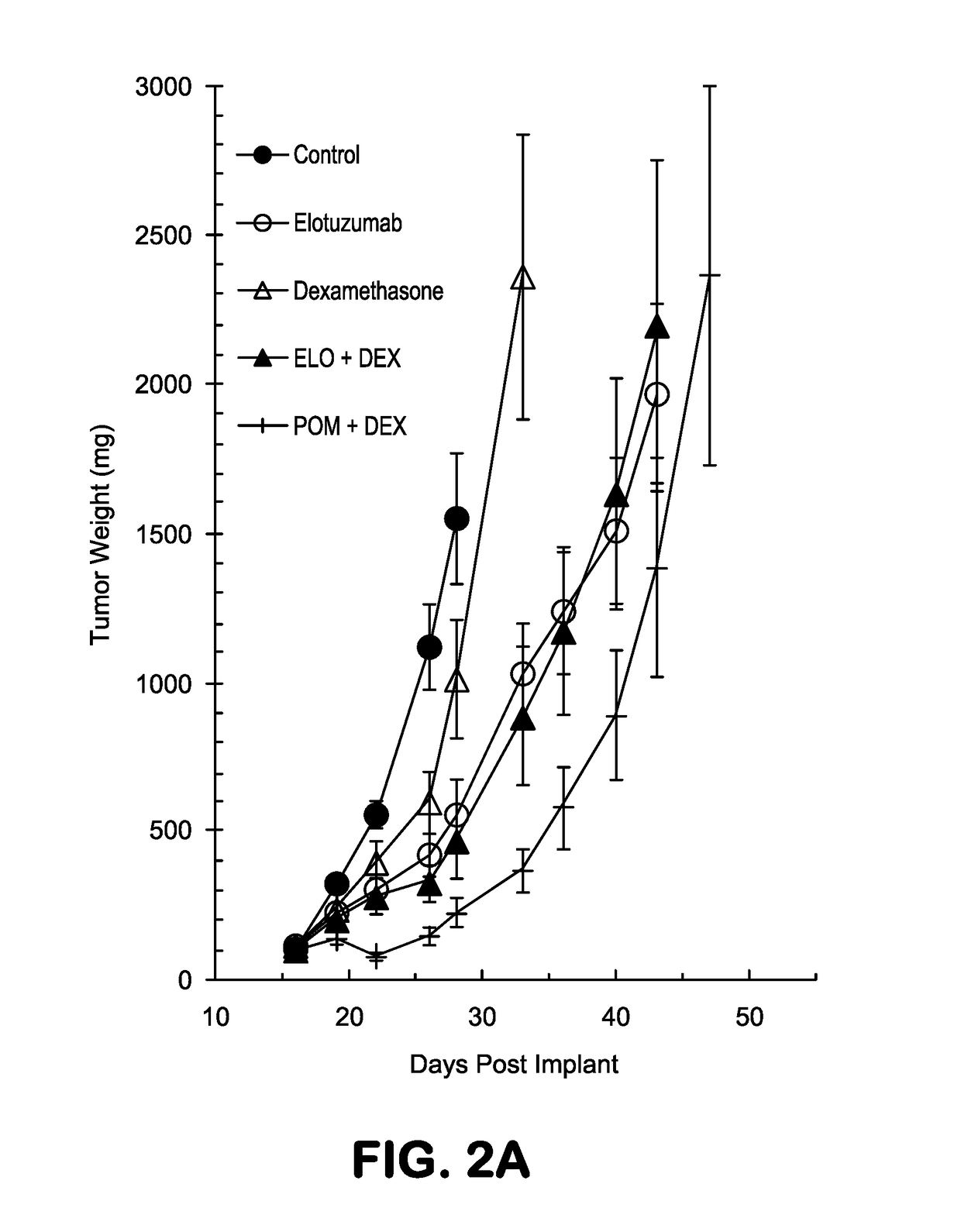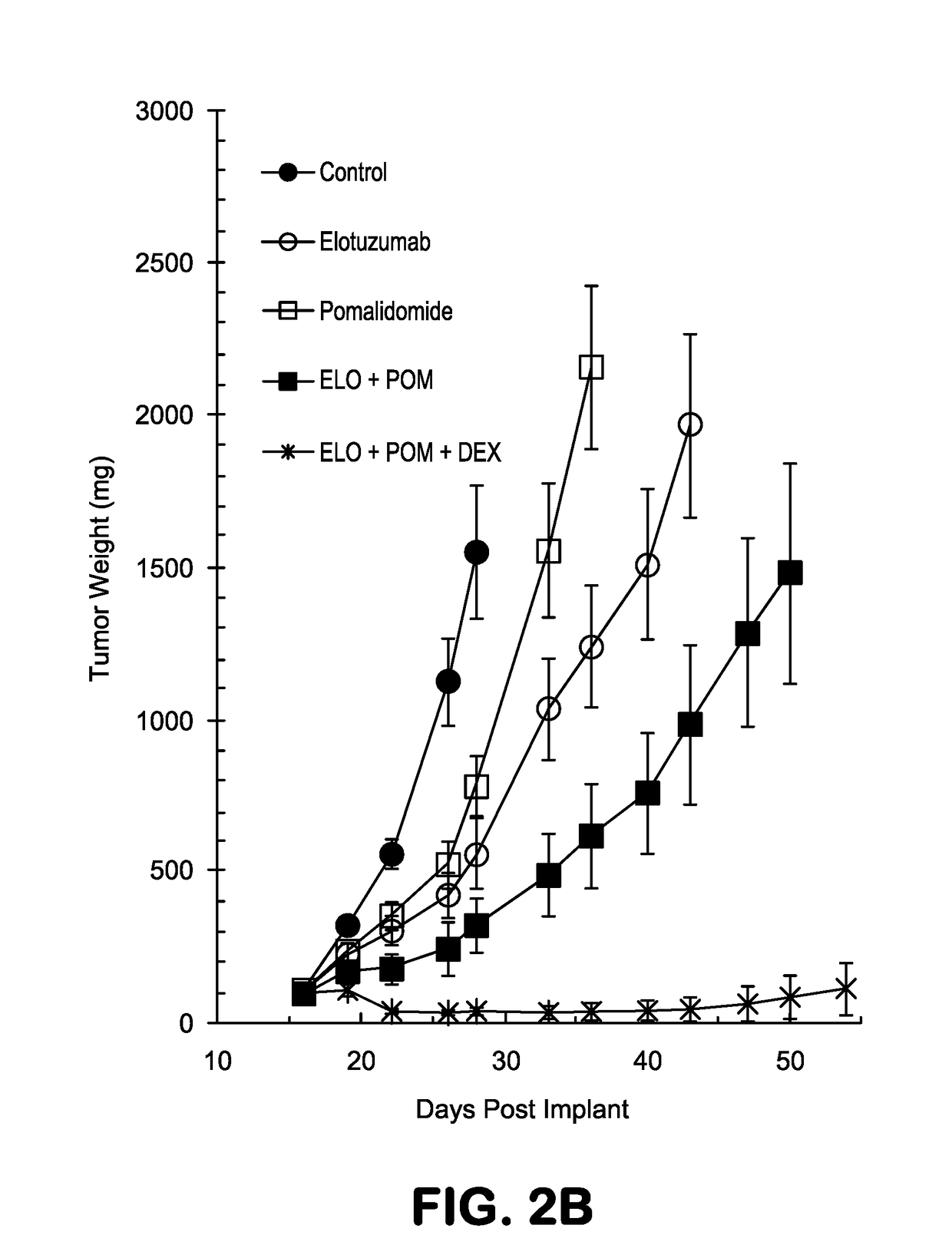Immunotherapeutic dosing regimens comprising pomalidomide and an Anti-cs1 antibody for treating cancer
a technology of antics1 antibody and immunotherapy, which is applied in the direction of antibody medical ingredients, drug compositions, peptides, etc., can solve the problems of fatigue, headache, debilitating side effects, and almost all multiple myeloma patients relapse, and achieve synergistic treatment effect, good partial response, and stable diseas
- Summary
- Abstract
- Description
- Claims
- Application Information
AI Technical Summary
Benefits of technology
Problems solved by technology
Method used
Image
Examples
example 1
or Assessing the Therapeutic Effect of Combining an Anti-CS1 Antibody with Pomalidomide in an OMP-2 Multiple Myeloma Xenofraft Tumor Mouse Model—Study #1 OPM2-15
[0352]In vivo mouse studies have demonstrated that elotuzumab administered intraperitoneally (IP) inhibits tumor growth of human myeloma xenografts (Hsi et al., Clin. Cancer Res., 14:2775-2784 (2008); and Tai et al., Blood, 112:1329-1337 (2008) in a dose-dependent fashion (Tai et al. (2008)). The anti-tumor activity of elotuzumab in xenograft models can be enhanced by co-administration with the small molecules, bortezomib (reversible inhibitor of the chymotrypsin-like activity of the 26S proteasome in mammalian cells) and lenalidomide (analogue of thalidomide with immunomodulatory, anti-angiogenic, and anti-neoplastic properties) (Balasa et al., Cancer Immunol. Immunother., 64:61-73 (2015). In addition to lenalidomide, a second Imid, pomalidomide, is approved for MM treatment. Due to its direct anti-tumor activity dexamethas...
example 2
or Assessing the Therapeutic Effect of Combining an Anti-CS1 Antibody with Pomalidomide in an OMP-2 Multiple Myeloma Xenofraft Tumor Mouse Model—Study #2 OPM2-16
[0368]The synergistic results observed in Study #1 OPM2-15 that is described in Example 1 were repeated. The materials and methods used in this set of experiments were identical to those described in Example 1 unless specified otherwise.
Results
[0369]The data presented in FIGS. 4A-B show tumor growth curves for all groups in Study #2 (OPM2-16) presented as means+ / −standard deviation, and the data in FIGS. 5A-H represent measured tumor volumes of all individual animals in each treatment group for Study #2. In this study (OPM2-16), when compared to untreated mice, treatment with elotuzumab, pomalidomide, or dexamethasone as single agents had TGI values of 57.7%, 41.4%, and 62.8%, respectively (Table 3). The combination of pomalidomide and elotuzumab demonstrated better efficacy than either of the agents alone (TGI=72.5%, Table ...
example 3
abel, Randomized Phase 2 Trial Investigating the Combination of Pomalidomide / Dexamethasone with or without Elotuzumab in Relapsed and Refractory Multiple Myeloma
Research Hypothesis
[0372]The addition of elotuzumab to pomalidomide and dexamethasone (investigational combination therapy) will increase the progression free survival (PFS) in subjects with relapsed and refractory multiple myeloma
Objectives
[0373]The primary objective is to compare progression free survival (PFS) between treatment arms.
[0374]The secondary objective is to compare objective response rate between treatment arms as well as to compare overall survival between treatment arms.
[0375]Additional exploratory objectives are to evaluate the following: the safety and tolerability of the investigational combination therapy; the time to response and duration of response; the pharmacokinetics and immunogenicity of elotuzumab in presence of pomalidomide and dexamethasone; the relationship between changes in soluble SLAMF7 (sS...
PUM
| Property | Measurement | Unit |
|---|---|---|
| time | aaaaa | aaaaa |
| time | aaaaa | aaaaa |
| time | aaaaa | aaaaa |
Abstract
Description
Claims
Application Information
 Login to View More
Login to View More - R&D
- Intellectual Property
- Life Sciences
- Materials
- Tech Scout
- Unparalleled Data Quality
- Higher Quality Content
- 60% Fewer Hallucinations
Browse by: Latest US Patents, China's latest patents, Technical Efficacy Thesaurus, Application Domain, Technology Topic, Popular Technical Reports.
© 2025 PatSnap. All rights reserved.Legal|Privacy policy|Modern Slavery Act Transparency Statement|Sitemap|About US| Contact US: help@patsnap.com



